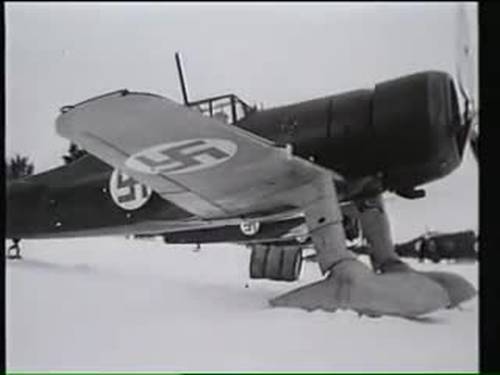Saturday 6 January 1940
 |
| Fokker D.XXI Finnish fighter. |
Time to finish off the reeling Soviet 44th Rifle Division. On the Raate road, the Finns begin at 3 a.m. They attack 5 miles east of Mäkinen’s original roadblock near Suomussalmi. The Soviet soldiers flee into the forests, where the Finns on skis track them down. In any event, there is nothing for them there, no shelter, so most soon perish in the bitter, lifeless cold.
Task Force Fagernas continues holding the Purasjoki River crossing area where they blew up the bridge on 5 January 1940. The NKVD troops from the USSR attempt to get by them to relieve their comrades further east, but fail. The Task Force also has enough troops to spare to cut the Ratte road further west as well.
Comrade Vinogradov, in command of Soviet 44th Rifle Division, radios Chuikov at 9th Army HQ that his men can only return through the forest and must leave all their equipment behind. Chuikov replies that the men must wait where they are until relief forces arrive. However, Chuikov himself asks the Stavka for instructions, requesting a breakout without the heavy equipment.
Division headquarter has lost all contact with the Division on the Ratte road except with the 122nd Artillery Regiment and the 305th Rifle Regiment.
Late in the day, the Finns construct a barrier near the border. Vinogradov breaks down at 16:00 and tells his subordinates to break out at 22:00. Everything is put into the effort, which is led by two rifle companies of the 25th Rifle Regiment under Major Plyukhin. Two batteries of artillery, tanks, and the rest of the Division follow along. The vast majority of the wounded are left behind on the road.
The breakout begins sometime during the night. The breakout failed immediately. The Soviets abandoned their heavy equipment and ran north of the road, into the woods. The vast majority of the heavy equipment remained intact. The fleeing Soviet troops then headed eastward through deep snow, about 2-3 kilometers away toward the border. One group, the 305th Regiment, escaped without opposition. Vinogradov, who had joined the column at some point, escaped guarded by two rifle companies and a Guard Platoon.
Winter War Air Operations: A group of Ilyushin bombers is flying over Utti, 60 miles northeast of Helsinki, when two Finnish Fokker D.XXI fighters intercept them and shoot seven of them down. Finnish pilot Jorma Sarvanto shoots down six of them in 25 minutes.
Battle of the Atlantic: The Kriegsmarine issues orders to its U-boats to "make immediately unrestricted use of weapons against all ships" in an area of the North Sea the limits of which were defined. [This is according to testimony and evidence of Admiral Doenitz at the Nuremberg trials following World War II.]
Royal Navy submarine HMS Undine (Lt. Cdr. Alan Spencer Jackson) is captured by Kriegsmarine minesweepers in the Heligoland Bight but sinks due to demolition charges before it can be boarded. Commander Jackson had attacked three trawlers which turned out to be heavily armed German auxiliary minesweepers.
The British 8,317-ton liner City of Marseilles hits a mine in the River Tay of Scotland but is towed to port by salvagers after the crew abandons ship. The mine had been laid by U-13 on 12 December 1939. One crew perishes, 13 survive.
The Kriegsmarine conducts more mine-laying operations in the English Channel.
US passenger liner Manhattan detained by the British at Gibraltar.
Convoy OG 13 forms at Gibraltar, HX 15 departs from Halifax.
Italian/Hungarian Relations: The two foreign ministers, Ciano and Csaky, meet in Venice.
Soviet/Norwegian Relations: The Norwegian government denies the Soviet accusation that is it not acting in a neutral fashion in the Winter War.
British/ Norwegian Relations: The British demand access to Norwegian waters for operations due to German attacks on shipping.
Holland: The government announces that it will defend itself against any attack.
Ireland: Prime Minister Eamon de Valera calls for emergency powers to increase pressure on the IRA. The Emergency Powers Act has been found wanting, as the Irish courts set free 53 men who had been detained as suspected terrorists. The Dall (Irish Parliament) considers a much tougher bill that would authorize their detention without trial or due process.
United States Military: Admiral James Richardson takes command of the fleet in Hawaii.
United States Homefront: Duke indoor stadium is dedicated.
 |
| New York City, January 6, 1940. Before environmental protections, a heavy haze over the city was common. Now, it is rare. |
January 1940
January 1, 1940: Finns Carve up the SovietsJanuary 2, 1940: Finnish Counterattacks Continue
January 3, 1940: Soviets Trapped
January 4, 1940: Soviet Breakout Attempts Fail
January 5, 1940: Dicing Up the Soviets
January 6, 1940: Soviet 44th Division Runs
January 7, 1940: Shakeup in Soviet High Command
January 8, 1940: Ratte Road Battle Ends
January 9, 1940: British Submarines in Peril
January 10, 1940: Mechelen Incident
January 11, 1940: Finns Surround More Soviets
January 12, 1940: New Soviet Attacks at Taipale
January 13, 1940: Fall Gelb Postponed
January 14, 1940: Japan's Government Falls
January 15, 1940: Soviets Prepare More Carefully
January 16, 1940: German Atrocities Uncovered
January 17, 1940: Bletchley Park in Action
January 18, 1940: New Hope for Allied Shipping
January 19, 1940: Finnish Attacks at Salla
January 20, 1940: Churchill Urges Cooperation
January 21, 1940: Asam Maru Incident
January 22, 1940: Dissension Within British Government
January 23, 1940: Dissension in South Africa
January 24, 1940: NKVD Blocking Detachments
January 25, 1940: Auschwitz Site Selected
January 26, 1940: Millionaire Bunker Destroyed
January 27, 1940: U-20 Sinks Four Ships
January 28, 1940: Softening Up the Finns
January 29, 1940: Moscow Willing to Talk
January 30, 1940: Hitler Throws Down the Gauntlet
January 31, 1940: Timoshenko Is Ready
2019
No comments:
Post a Comment